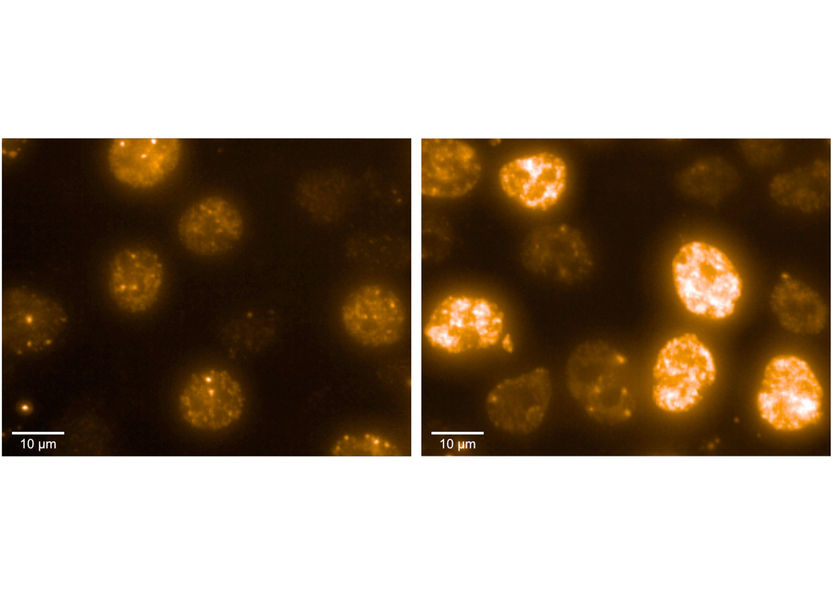Critical conflict in cancer cells
The results of the study may possibly be used for future therapies
The cells of a certain tumour type, called neuroblastoma, divide very rapidly. This rapid division can have potentially fatal consequences for them. A new study shows how neuroblastoma cells deal with this dilemma.

Neuroblastoma cells under the microscope. The staining represents DNA damage, the more intense, the more severe and dangerous the damage. Cells on the right have no RNA exosome and are therefore much more susceptible to such damage.
Imaging Core Facility / JMU
Neuroblastomas occur predominantly in children. A specific subset of these tumours is very aggressive and difficult to treat. Researchers worldwide are therefore trying to find an Achilles' heel of the disease.
Around 50 percent of high-risk neuroblastomas attribute their malignancy to a protein called MYCN. The substance stimulates the activity of certain genes in the cancer cell that accelerate tumour growth. However, it is this very fact that makes MYCN partly responsible for a dilemma which could turn out to be a significant inherent weakness, since neuroblastoma cells are also characterised by increased division rates. Before each division, the affected cell must produce a complete copy of its entire genetic information. One of the two daughter cells then receives this copy, the other the original.
At the same time, however, parts of this information, namely the tumour-specific genes activated by MYCN, must be transcribed. "The cell has to coordinate these two processes," Dimitrios Papadopoulos explains; a postdoctoral researcher at the Biocenter at the Department of Biochemistry and Molecular Biology in the group of Professor Martin Eilers. "Otherwise, it runs the risk of suffering significant damage."
A complex copier creates the DNA duplicate
It is like trying to read passages of a book while simultaneously copying it. Obviously, errors may occur in the process. The neuroblastoma cell is no exception. A complex copier inside the cell gradually generates a duplicate of the genetic material, the DNA, in a process called replication. At the same time, another process takes place as well, transcription. A totally different machinery transcribes the DNA segments, which the cell needs because they contain the building instructions for proteins.
Replication and transcription run parallel to some extent also in healthy cells. In neuroblastomas, however, MYCN significantly worsens this situation. "This results in conflicts," says Papadopoulos. "As a result, the DNA thread can break, for example. If this defect is not repaired quickly, this means a death sentence for the cell." Together with colleagues, he has studied how cancer cells cope with this threat.
Supported by a cellular shredder
The cell thus uses two different mechanisms: On the one hand, MYCN can call a kind of shredder in the cell nucleus to its aid, the RNA exosome. It disables the creation of the transcripts required for protein production. This enables the DNA copier to do its job more easily.
If MYCN cannot recruit an exosome, it will alternatively recruit a molecule called BRCA1. This molecule can stop early transcription. In addition, the whole transcription machinery is removed paving the way for the copier.
The results of the study may possibly be used for future therapies, too. The researchers hope to disrupt the cooperation between MYCN and BRCA1 by using suitable active substances. "If we then also prevent MYCN from calling the exosome to its aid, significant DNA damage could accumulate in tumour cells," explains Dimitrios Papadopoulos. "This way, they might possibly be killed – in a highly selective manner without fear of damaging other cells."
























































